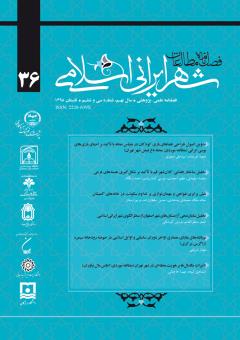تاثیرات مگامالها بر هویت محلهای در شهر تهران؛ مطالعه موردی: اطلس مال نیاوران
محورهای موضوعی : شهرسازی اسلامیاسماعیل شیعه 1 , مهسا حاجیانی 2
1 - استاد گروه شهرسازی دانشگاه علم و صنعت ایران
2 - کارشناسی ارشد برنامه ریزی شهری دانشگاه علم و صنعت ایران
کلید واژه: بازار, مجموعههای تجاری بزرگ مقیاس, مگامال, هویت محلهای, هویت مکانی, اطلس مال,
چکیده مقاله :
بازارها، نقش اساسی و غیر قابل انکاری در هویتبخشی فرهنگی، ملی و بومی به شهرهای ایرانی - اسلامی بر عهده داشتهاند، به نحوی که حیات شهر در پیوند با بازار رقم میخورد؛ اما با تغییر و تحول اینگونه فضاهای تجاری و شکلگیری مجتمعهای تجاری در فضای مدرن و بهخصوص با تاسیس مگامالها نگرانیهای جدی درباره تاثیرات این فضاها بر هویتهای مکانی به وجود آمده است. بر این اساس سوال اصلی مقاله حاضر آن است که احداث و فعالیت مگامالها چه تاثیری بر هویتهای جمعی و به طور مشخص هویت محلهای به جا خواهد گذاشت؟ پیشفرض اصلی نویسندگان آن است که هویت محلهای (به عنوان یک سطح از هویت مکانی) پدیدهای متغیر است و تحت تاثیر بافتهای شهری و عناصری مانند مگامالها قرار گرفته و تضعیف میشود. به منظور بررسی این فرضیه، مورد مطالعاتی اطلس مال که در منطقه نیاوران در حال احداث است، انتخاب شد. این پژوهش با رویکرد آیندهپژوهی انجام شده و روش تحقیق آن ترکیبی از روشهای کمی و کیفی بوده است. در ابتدا وضعیت کنونی هویت محلهای با روش نظرسنجی و با حجم نمونه 300 نفری از اهالی سه محله اطراف (محلات بلافصل) پروژه مورد سنجش قرار گرفت. همچنین برای پیشبینی تاثیرات احتمالی پروژه بر هویت محلهای ساکنان توأمان از روشهای مراجعه به خبرگان دانشگاهی، مراجعه به مطلعین و خبرگان محلی و نیز بررسی تاثیر سه مجتمع در حال فعالیت (تیراژه، ارگ و کوروش) استفاده شد. یافته اصلی مقاله آن است که هویت محلهای فعلی در محلات سهگانه اطراف اطلس مال در حدی قوی (بالاتر از میانگین) قرار دارد و دیگر آنکه تاثیر اطلس مال بر هویت محلهای اهالی، در ارتباط با (و منوط به) شش پیشران کلیدی دیگر مانند مصرف گرایی، حضور برندهای خارجی، معماری مدرن، ترافیک و حمل و نقل، ازدحام و شلوغی بازدید کنندگان، قیمت زمین و املاک قرار دارد. در نهایت باید گفت پیشبینی میشود تاثیرگذاری پروژه اطلس مال بر هویت محلهای به صورت بسیار تدریجی، آهسته و کند خواهد بود و امکان سیاستگذاری و برنامهریزی برای کاهش اثرات منفی آن وجود دارد که این مهم بر عهده مدیران شهری و مدیریت پروژه، پیش و پس از شروع فعالیتهای مجتمع اطلس مال است.
Throughout history, markets have played a major undeniable role in shaping the cultural, national and native identity in Iranian-Islamic cities, so that the urban life is closely associated with the market. However, given recent changes in market dynamics and the emergence of modern supersized malls, serious concerns are being raised about the impact of these spaces on local identities. That said, the main purpose of this research is to investigate the influence of construction and activity of large-scale shopping centers on the collective identity in general and neighborhood identity in particular. The authors’ primary assumption is that neighborhood (as a level of place identity) is a variable influenced by urban textures and is weakened by elements such as megamalls. Atlas Mall project (under construction) in the Niavaran district was chosen as a case study to investigate this hypothesis. A futurological approach was adopted in the research with a combination of quantitative and qualitative methods. The current status of neighborhood identity was measured by a survey with a sample of 300 respondents who were the residents of three (immediate) surrounding neighborhoods. Referring to academic expertise, referring to informants and local experts, and also the studies on the impact of three operating shopping centers (Tirazheh, Arg and Kourosh) were used to predict the potential effects of Atlas Mall on the residents’ neighborhood identity. The findings show that the neighborhood identity in the three neighborhoods is strong (above average) and the impact of Atlas Mall on the residents’ identity is associated with (and under the influence of) six other key drivers: consumerism, the presense of foreign brands, modern architecture, traffic and transportation, crowdedness, and the price of real properties. It can be predicted that the impact of Atlas Mall on neighborhood identity will be gradual, so some planning and policy-making efforts can be done, before and after its inauguration, by urban managers or the project managers in order to reduce the impacts.
